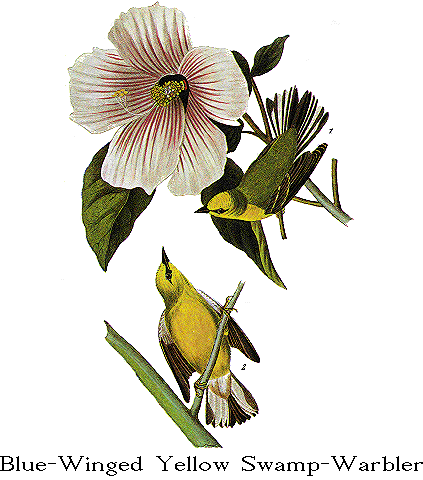Birds of America
By John James Audubon, F. R. SS. L. & E.
VOLUME II.



Family
Genus

BLUE-WINGED YELLOW SWAMP-WARBLER.
[Blue-winged Warbler.]
HELINAIA SOLITARIA, Wils.
[Vermivora pinus.]

PLATE CXI.--MALE, AND FEMALE.
This pretty little Warbler is migratory, and arrives in Louisiana from the
south in the beginning of spring. It is found in open woods, as well as in the
vicinity of ponds overgrown with low bushes and rank weeds. Along with a pair
of Blue-winged Yellow Warblers, I have represented a species of Hibiscus, which
grows on the edges of these ponds. Its flowers are handsome, but unfortunately
have no pleasant odour.
The species which now occupies our attention is a busy, active bird, and is
seen diligently searching among the foliage and grasses for the small insects on
which it feeds, mounting now and then towards the tops of the bushes, to utter a
few weak notes, which are in no way interesting.
Its nest, which is singularly constructed, and of an elongated inversely
conical form, is attached to several stalks or blades of tall grass by its upper
edge. The materials of which it is formed are placed obliquely from its mouth
to the bottom. The latter part is composed of dried leaves, and is finished
within with fine grass and lichens. The female lays from four to six eggs, of
a pure white colour, with a few pale red spots at the larger end. The first
brood is out about the middle of May, the second in the middle of July. The
young disperse as soon as they are able to provide for themselves, this bird
being of solitary habits.
It leaves Louisiana in the beginning of October. I have never seen this
species farther eastward than the State of New Jersey, where I have killed
several within a few miles of Philadelphia. It is frequent in the barrens of
Kentucky, and up the Mississippi, as far at least as St. Genevieve, where I shot
two individuals many years ago.
Its flight is short, undetermined, and is performed in zig-zag lines, as in
most of its tribe. It sometimes ascends twenty or thirty yards in the air, as
if with an intention of going to a great distance, but still moving in a zig-zag
manner, when it suddenly turns about, and comes down near the place from which
it set out. It does not chase insects on wing, but feeds in a great measure on
the smaller kinds of spiders, not neglecting, however, to seize other insects
when they come within reach. It remains almost constantly among the bushes, and
is seldom seen on trees of any size.
BLUE-WINGED YELLOW WARBLER, Wils. Amer. Orn., vol. ii. p. 109.
SYLVIA SOLITARIA, Bonap. Syn., p. 87.
BLUE-WINGED YELLOW WARBLER, Sylvia solitaria, Nutt. Man., vol. i. p. 410.
BLUE-WINGED YELLOW WARBLER, Sylvia solitaria, Aud. Orn. Biog., vol. i.p. 102.
Adult Male.
Bill nearly as long as the head, straightish, subulato-conical, acute, as
deep as broad at the base, the edges acute, the gap line a little deflected at
the base. Nostrils basal, lateral, elliptical, half-closed by a membrane. Head
rather small. Neck short. Body slender. Feet of ordinary length, slender;
tarsus longer than the middle toe, covered anteriorly by a few scutella, the
uppermost long; toes scutellate above, the inner free, the hind toe of moderate
size; claws slender, compressed, acute, arched.
Plumage soft, blended, tufty. Wings of ordinary length, acute, the second
quill longest. Tail longish, rounded when expanded, slightly forked when
closed.
Bill black, with a pale margin. Iris dark brown. Feet and claws
flesh-colour, tinged with yellow. Forehead, crown, and under parts of a rich
bright-yellow. Back of the head and neck, the back and upper tail coverts
bright grass-green. Lore black. Wings greyish-blue, slightly margined with
paler, the first two rows of coverts tipped with whitish. Four middle
tail-feathers greyish-blue, the outer webs of the rest, and an oblique portion
of the outer feather at the end, of the same colour, their inner webs white.
Length 4 3/4 inches, extent of wings 7; bill along the ridge 1/2, along the
gap 1.
Adult Female.
The female scarcely differs from the male in appearance, and is of nearly
the same dimensions.
LARGE-FLOWERED HIBISCUS, COTTON ROSE, OR WILD ALTHAEA.
HIBISCUS GRANDIFLORUS, Mich. Fl. Amer., vol. ii. p. 46. Pursch, Fl. Amer.,p. 455.--MONADELPHIA POLYANDRIA, Linn.--MALVACEAE, Juss.
This beautiful species of Hibiscus, which does not precisely agree with any
that I have seen described, although it is probably the above, is characterized
by its ovato-cordate, obtusely and irregularly serrated, acute, venous tough
leaves, and its large rose-coloured flowers, which are deep red at the base, and
streaked with the same colour. The corolla is about five inches in diameter,
the anthers yellow. The stem and leaves are smooth. It grows in salt marshes,
and by the edges of pools.









